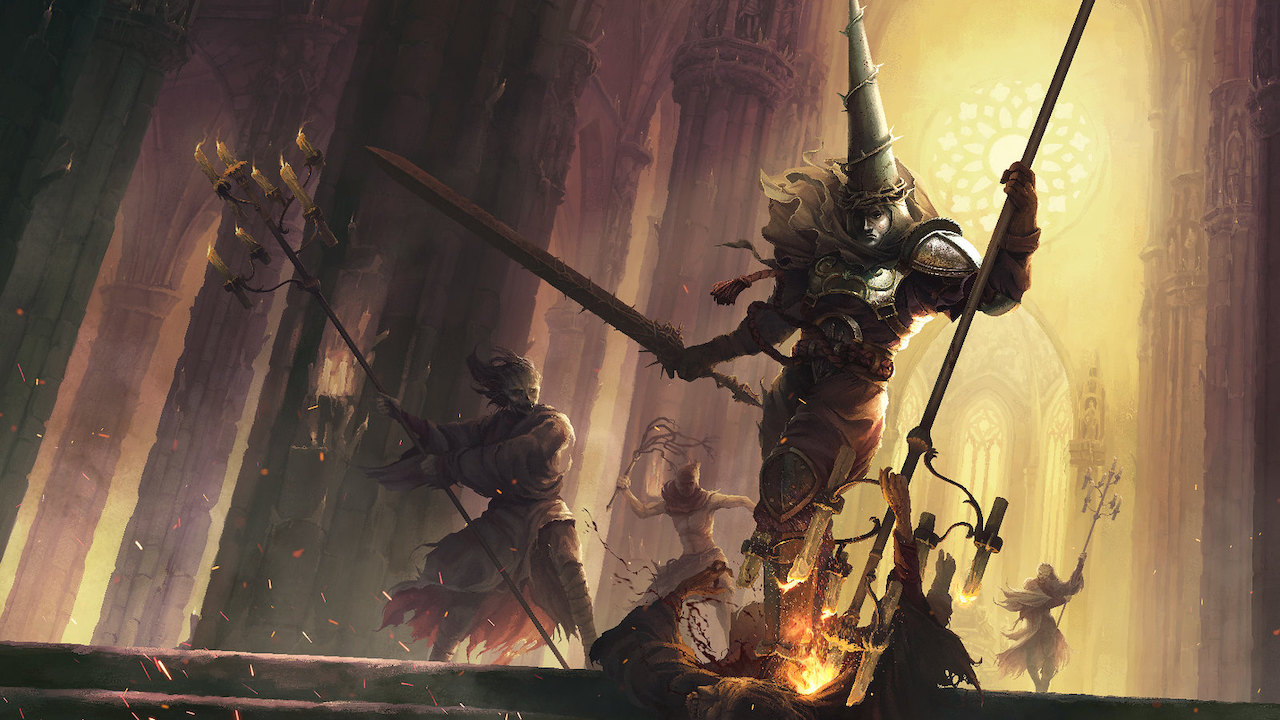
A few years back I remember listening to a podcast subtitled ‘Prophets of Doom’ from Dan Carlin’s Hardcore Histories series. Set 500 years ago in Münster, Germany, the translation of the Bible from Latin to the common tongue inadvertently lead to a much darker, often harrowing interpretation and misuse of the power that can come with religion. I bring this particular podcast up because the cruel and torturous world represented in Blasphemous would paint an abstract resemblance of what I once visualized when listening to that six-hour-long story.
It’s the game’s pixel art style and riddle-tongued narrative that really sets the mood for Blasphemous’ religious undertones. You play as The Penitent One, a savior of sorts during an age of corruption where bodies are piled high and the mutual blasphemy would take rise to hellish creatures plaguing the dirt. Superstition and ritual practices are sewn in from the get-go, with our protagonist draining the blood from a slain beast into the very helmet that burdens his shoulders.
The 2D visual style is wonderfully and grotesquely molded together in a way that reminded me of Amiga’s Shadow of the Beast fused with the troubling mood of religious medieval art. The way that bosses animate somewhat reflects the unsettling stop motion masterworks of Ray Harryhausen. The layered backdrops are just as equally impressive, displaying both a sense of scope and atmosphere that bleeds across the screen.

However, given the theme and gameplay traits that Blasphemous is going for, it does inevitably set itself up to be compared to the likes of Dark Souls and Bloodborne. Those two games, in particular, have set their foundations deep enough to make it almost impossible to avoid inspiration. The gameplay in Blasphemous has clearly been heavily infected by Hidetaka Miyazaki’s vision with its simple, yet practical learn-from-your-mistakes combat system, route seeking shortcuts, and punishment in failure.
Facing death in itself will have you retreading your way back from distant checkpoints at a price of some magic meter. This fervor meter is generally used for special projectile attacks as well as temporary aids to assist survival. They can be reformed at certain monuments at a price, or rekindled at the spot of your demise – as opposed to the main form of currency that you would traditionally sacrifice and reclaim back in a Dark Souls game.
Everything else that is collected or activated thankfully stays that way after death as a welcome motive for convenience. However, the sacrifice of your fervor meter never really seems too big of a loss, as the core swordplay mechanics tend to be the more prominent go-to method anyway. Pursuing the route back towards where I last fell was oftentimes quite laborious and pace-breaking, usually due to having to wait around for some form of mechanical scrolling contraption or a change in wind direction to get back towards where I needed to be.

Still, these can be a common side effect of the Metroidvania formula that Blasphemous unsurprisingly leans towards. Yet, it doesn’t always hit the satisfaction of character ability progression of the more famous examples out there that represent the genre. Regardless of which item you collect, it’s hard to know, or even care, of their significance by how they are all represented in-game as a black orb with smoke rising from it. Despite being well written, the descriptions of certain items found in the layers of sub-menus are often quite cryptic too, forcing the player to assume that they are for some additional cause presented towards a monument or character they may or may not have already simply stumbled across.
The controls, for the most part, are smooth and responsive, although slight periodic framerate hiccups can be a distraction when controlling the character during the more enemy-filled platform heavy moments. The automatic ledge-clinging can also be a little frustrating when hopping between lower ledges placed closely together. One thing I did find strange was how the map can’t be closed with the same minus button that summons it. The only way I could seem to close the map was by pressing the jump button which always forced my character to spring into a jumping animation upon exit – sometimes even into an enemy or trap.
These are generally minor inconveniences which you can adapt to with a bit of time. While the character movement doesn’t feel quite as fluid to control as, say, Dead Cells, The Penitent One’s maneuverability is still more than fit for purpose. The combat consists of slamming a single attack button against one of four directions, while a Mega Man-style slide acts as a method for evasion. Not everything can be dodged, but more often than not enemies can be parried to exchange a counter.

Each enemy has their own distinct attack pattern to learn that tailors nicely around the simple, but effective combat system. The variety of enemies encountered throughout the game are impressively consistent from beginning to end. Each one full of imagination so disturbing that the artist working on the visuals clearly had traumatic nightmares as a child. Tortured souls bound by holy props used as weapons, hunchbacks sheltering underneath cracked church bells, and nuns swinging giant urns filled with crooked limbs are just a small sample of the many horrors that await.
While the standard enemy type oozes with surreal craftsmanship, the bosses waiting beyond them push the envelope even further. The remains of an archbishop’s corpse raised by a celebration of arms and a blind giant baby cradled by a crown of thorns are as wonderfully horrific as sound. Other than the enemies, the story itself has very few supporting characters, although some that are present can be hauntingly memorable – one example being a certain pilgrim bound by his elbows and weighed down with stone. His presence not only represents his focused dedication to his faith which fits in perfectly here but it also conjures a curiosity to where his journey leads him too.
The sound and music to accompany your treacherous journey is as equally beautiful as it is eerie. Unsurprisingly, it’s worth noting that Blasphemous is very challenging at times. Yet, besides some dirty tricks up its sleeves and a handful of perilous blind jumps, it all fits in with the old cliche of every death being a learning experience.
The setting and tone alone of Blasphemous stands out more than enough to be worth the experience that it provides. It may not be the best Metroidvania on the market, nor does it quite rival the essence of the original Dark Souls. However, such triumphs are so incredibly highly regarded to the point that it almost seems unfair to compare such a small ambitious project to them. What Blasphemous does achieve though, it does so well enough to warrant itself as a strong contender on the market. It’s probably one of the best looking indie games of the year, accompanied by incredibly effective notes of religious horror. More importantly, minus a few small gripes, it’s still a very enjoyable game to play through. Definitely one to sink into when the clocks go back in time for the dawn of All Hallows Eve.
Version Tested: Nintendo Switch
Review copy provided by Team17

 Original Article © nintendo-insider.com
Original Article © nintendo-insider.com




No comments
Post a Comment